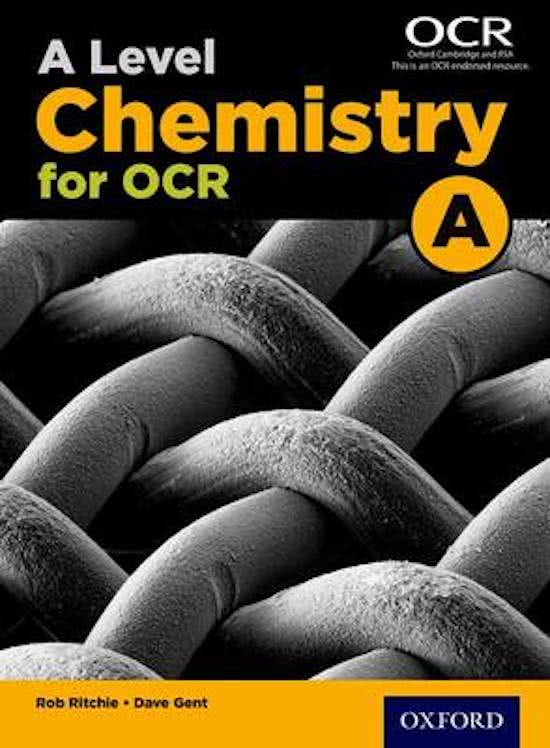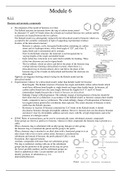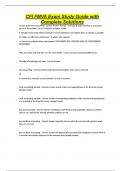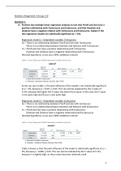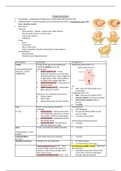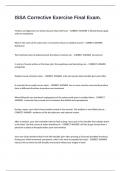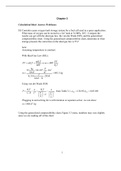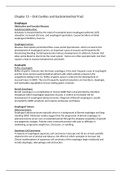Module 6
6.1.1
Benzene and aromatic compounds
• Development of the model of benzene over time:
The Kekulé structure for benzene shows the ring of carbon atoms joined
by alternate C-C and C=C bonds where the π bonds are localised between two carbons and the
π electrons are located between the two carbons
The Kekulé model was subsequently replaced by the delocalised model of benzene which was
accepted by the scientific community in light of supporting experimental evidence.
Features of the delocalised structure:
- Benzene is a planar, cyclic, hexagonal hydrocarbon containing six carbon
atoms and six hydrogen atoms, with a bond angle of 120°, and it has 12
sigma bonds and is unsaturated and is aromatic
Note: In the Kekule structure, the molecule is not hexagonal due to
varying lengths of the single and double bonds
- Each carbon has 4 electrons in its outer shell available for bonding. Three
of the four electrons are used in sigma bonds
- The 6 p-orbitals, which are above and below the plane of the benzene ring,
overlap sideways forming a delocalised π-system, where there is a
delocalised ring of electron density above and below the plane of the
benzene ring as the π bonds are delocalised and therefore the electrons are
delocalised
Opposite are diagrams showing orbital overlap for the Kekulé model and the
delocalised model
• Experimental evidence for a delocalised model, rather than Kekulé model for benzene:
- Bond lengths: The Kekulé structure of benzene has single and double carbon-carbon bonds which
would have different bond lengths as single bonds are longer than double bonds. In benzene, all
carbon-carbon bonds have the same length, between the lengths for C-C and C=C bonds
(intermediate length) because the π bonds in benzene are delocalised
- Enthalpy Change of Hydrogenation: The enthalpy change of hydrogenation of benzene should be
three times that of cyclohexene, in accordance to the Kekulé model, as benzene contains three double
bonds, compared to one in cyclohexene. The actual enthalpy change of hydrogenation of benzene is
less negative/more positive/less exothermic than expected. The actual structure of benzene is more
stable than the Kekulé structure.
- Resistance to reaction: If benzene contained the C=C bonds in the Kekulé model, it should
decolourise bromine, through electrophilic addition. However, benzene does not decolourise bromine
and doesn’t react by electrophilic addition and only reacts with Br2 at high temperatures and in the
presence of a halogen carrier
• IUPAC Rules of nomenclature can be used to systematically name substituted aromatic compounds
Some groups are shown as prefixes to benzene, whereas in other compounds the benzene ring is present as a
suffix.
When a benzene ring is substituted with an alkyl group, halogen or nitro group,
the benzene ring is considered the parent and the group is the prefix.
When a benzene ring is attached to an alkyl chain with a functional group or to an
alkyl chain with seven or more carbon atoms, benzene is considered the
substituent and instead of benzene, the prefix phenyl (C6H5) is used.
Exceptions (See opposite bottom)
Aromatic compounds with more than one substituent group:
The ring is numbered, starting with one of the substituent
groups and the positions on the groups on the ring are given
the lowest possible numbers and the substituent groups are
listed in alphabetical order. Locant numbers are used to
identify positions of substitution e.g. 2,4-
dinitromethylbenzene.
, Note: if benzene is the substituent, the carbon containing the functional group becomes the first carbon e.g.
the carbon bonded to the hydroxyl group in a phenol is the first carbon
Electrophilic substitution
• Arenes (benzene and substituted aromatic hydrocarbons) undergo electrophilic substitution reactions in which
a hydrogen atom (Not always as it could be another substituent group being replaced by the nitronium or
bromonium ion) on the benzene ring is replaced by an electrophile.
- Nitration of benzene
The arene reacts with concentrated nitric acid in the presence of concentrated sulphuric acid at 50°C.
H2SO4 acts as a catalyst. To form dinitrobenzene, twice the moles of nitric acid are required
C6H6 + HNO3 → C6H5NO2 +H2O
Mechanism:
1. Formation of the electrophile, NO2+
Concentrated HNO3 and concentrated H2SO4 react to form the nitronium ion, NO2+
H2SO4 + HNO3 → NO2+ + H2O + HSO4-
2. Formation of the organic compound, C6H5NO2
3. Regeneration of the H2SO4 catalyst
The H+ formed in step 2 reacts with the HSO4- ion from step 1 to regenerate the catalyst, H2SO4
HSO4- + H+ → H2SO4
- Halogenation of benzene
Aromatic compounds only react with halogen in the presence of a halogen carrier. Halogen carriers
include iron, iron halides and aluminium halides and they introduce a permanent dipole on the
molecule
C6H6 + Br2 → C6H5Br +HBr
Mechanism:
1. Formation of the electrophile, Br+
The halogen (e.g. bromine) reacts with the halogen carrier (e.g. Iron Bromide) to form the (e.g.
bromonium) ion. The halogen carrier (e.g. FeBr3) acts as a catalyst
Br2 + FeBr3 → Br+ + FeBr4-
2. Formation of the organic compound, C6H5Br (Monosubstituted organic product)
3. Regeneration of the FeBr3 catalyst
The H+ formed in step 2 reacts with the FeBr4- ion from step 1 to regenerate the catalyst, FeBr3
FeBr4- + H+ → HBr + FeBr3
- Alkylation and acylation (Friedel-Crafts reaction)
In the presence of a halogen carrier, a haloalkane or acyl chloride can add a carbon chain to an
aromatic ring, through the formation of a C-C bond, through electrophilic substitution.
❖ Alkylation: A haloalkane, e.g. RCl is
reacted with an aromatic compound to
introduce an alkyl group to the benzene
ring, in the presence of a halogen carrier
such as AlCl3
, ❖ Acylation: An acyl chloride, RCOCl is reacted
with an aromatic compound to form an
aromatic ketone. A halogen carrier such as
AlCl3 is required.
• The relative resistance to bromination (halogenation)
of benzene, compared with alkenes: In benzene, the π
bonds are delocalised and therefore the π electrons are delocalised. The electron density around any two C
atoms in the benzene ring is less than in an alkene where the π bond is localised between 2 carbons and π
electrons are localised between 2 carbons. When the non-polar Br2 molecule approaches the benzene ring,
there is insufficient π-electron density around any two C atoms to polarise the bromine molecule. Therefore,
benzene polarises Br2 less than in alkenes and benzene attracts Br2
less than alkenes do as benzene induces a weaker dipole in bromine
than alkenes do. This prevents any reaction taking place without
formation of Br+ in the presence of a halogen carrier.
Phenols
• Weak acidity of phenols:
Phenols are weak acids, partially
dissociating in water to form the
phenoxide ion and a proton. Phenols are
more acidic than alcohols but less acidic
than carboxylic acids. The weak acidity
of phenols is shown by the neutralisation
reaction of phenols with NaOH, but the
absence of reaction of phenols with carbonates. Phenols react with sodium hydroxide to form the salt sodium
phenoxide, C6H5Na and water in a neutralisation reaction. Sodium carbonate can be used to distinguish
between a phenol and a carboxylic acid as carboxylic acids react with Na2CO3 to form bubbles of carbon
dioxide. Phenols do not react with Na2CO3 and there are no gas bubbles.
To test for the presence of phenols, use pH indicator paper and then add aqueous sodium carbonate. You
would observe that the pH paper turns acid colour and no effervescence with Na2CO3(aq)
• Electrophilic substitution of phenols
- Bromination of phenol
Phenol reacts with an aqueous solution of
bromine (bromine water) by electrophilic
substitution. The reaction takes place at room
temperature and no halogen carrier is
required as phenols are more reactive than
benzene. Phenol decolourises the bromine
and a white precipitate of 2,4,6-tribromophenol is formed (trisubstituted organic product).
Monosubstitution or disubstitution with 1 or 2 Br2 molecules respectively can also occur
- Nitration of Phenols
Phenols react with dilute nitric acid at room
temperature to form a mixture of 2-nitrophenol or 4-
nitrophenol
Note that nitration with phenol does not require
concentrated HNO3 or the presence of a concentrated
H2SO4 catalyst
• Comparing the reactivity of phenol and benzene:
Electrophilic substitution of phenol is relatively easier than that
of benzene and the increased reactivity is caused the lone pair of
6.1.1
Benzene and aromatic compounds
• Development of the model of benzene over time:
The Kekulé structure for benzene shows the ring of carbon atoms joined
by alternate C-C and C=C bonds where the π bonds are localised between two carbons and the
π electrons are located between the two carbons
The Kekulé model was subsequently replaced by the delocalised model of benzene which was
accepted by the scientific community in light of supporting experimental evidence.
Features of the delocalised structure:
- Benzene is a planar, cyclic, hexagonal hydrocarbon containing six carbon
atoms and six hydrogen atoms, with a bond angle of 120°, and it has 12
sigma bonds and is unsaturated and is aromatic
Note: In the Kekule structure, the molecule is not hexagonal due to
varying lengths of the single and double bonds
- Each carbon has 4 electrons in its outer shell available for bonding. Three
of the four electrons are used in sigma bonds
- The 6 p-orbitals, which are above and below the plane of the benzene ring,
overlap sideways forming a delocalised π-system, where there is a
delocalised ring of electron density above and below the plane of the
benzene ring as the π bonds are delocalised and therefore the electrons are
delocalised
Opposite are diagrams showing orbital overlap for the Kekulé model and the
delocalised model
• Experimental evidence for a delocalised model, rather than Kekulé model for benzene:
- Bond lengths: The Kekulé structure of benzene has single and double carbon-carbon bonds which
would have different bond lengths as single bonds are longer than double bonds. In benzene, all
carbon-carbon bonds have the same length, between the lengths for C-C and C=C bonds
(intermediate length) because the π bonds in benzene are delocalised
- Enthalpy Change of Hydrogenation: The enthalpy change of hydrogenation of benzene should be
three times that of cyclohexene, in accordance to the Kekulé model, as benzene contains three double
bonds, compared to one in cyclohexene. The actual enthalpy change of hydrogenation of benzene is
less negative/more positive/less exothermic than expected. The actual structure of benzene is more
stable than the Kekulé structure.
- Resistance to reaction: If benzene contained the C=C bonds in the Kekulé model, it should
decolourise bromine, through electrophilic addition. However, benzene does not decolourise bromine
and doesn’t react by electrophilic addition and only reacts with Br2 at high temperatures and in the
presence of a halogen carrier
• IUPAC Rules of nomenclature can be used to systematically name substituted aromatic compounds
Some groups are shown as prefixes to benzene, whereas in other compounds the benzene ring is present as a
suffix.
When a benzene ring is substituted with an alkyl group, halogen or nitro group,
the benzene ring is considered the parent and the group is the prefix.
When a benzene ring is attached to an alkyl chain with a functional group or to an
alkyl chain with seven or more carbon atoms, benzene is considered the
substituent and instead of benzene, the prefix phenyl (C6H5) is used.
Exceptions (See opposite bottom)
Aromatic compounds with more than one substituent group:
The ring is numbered, starting with one of the substituent
groups and the positions on the groups on the ring are given
the lowest possible numbers and the substituent groups are
listed in alphabetical order. Locant numbers are used to
identify positions of substitution e.g. 2,4-
dinitromethylbenzene.
, Note: if benzene is the substituent, the carbon containing the functional group becomes the first carbon e.g.
the carbon bonded to the hydroxyl group in a phenol is the first carbon
Electrophilic substitution
• Arenes (benzene and substituted aromatic hydrocarbons) undergo electrophilic substitution reactions in which
a hydrogen atom (Not always as it could be another substituent group being replaced by the nitronium or
bromonium ion) on the benzene ring is replaced by an electrophile.
- Nitration of benzene
The arene reacts with concentrated nitric acid in the presence of concentrated sulphuric acid at 50°C.
H2SO4 acts as a catalyst. To form dinitrobenzene, twice the moles of nitric acid are required
C6H6 + HNO3 → C6H5NO2 +H2O
Mechanism:
1. Formation of the electrophile, NO2+
Concentrated HNO3 and concentrated H2SO4 react to form the nitronium ion, NO2+
H2SO4 + HNO3 → NO2+ + H2O + HSO4-
2. Formation of the organic compound, C6H5NO2
3. Regeneration of the H2SO4 catalyst
The H+ formed in step 2 reacts with the HSO4- ion from step 1 to regenerate the catalyst, H2SO4
HSO4- + H+ → H2SO4
- Halogenation of benzene
Aromatic compounds only react with halogen in the presence of a halogen carrier. Halogen carriers
include iron, iron halides and aluminium halides and they introduce a permanent dipole on the
molecule
C6H6 + Br2 → C6H5Br +HBr
Mechanism:
1. Formation of the electrophile, Br+
The halogen (e.g. bromine) reacts with the halogen carrier (e.g. Iron Bromide) to form the (e.g.
bromonium) ion. The halogen carrier (e.g. FeBr3) acts as a catalyst
Br2 + FeBr3 → Br+ + FeBr4-
2. Formation of the organic compound, C6H5Br (Monosubstituted organic product)
3. Regeneration of the FeBr3 catalyst
The H+ formed in step 2 reacts with the FeBr4- ion from step 1 to regenerate the catalyst, FeBr3
FeBr4- + H+ → HBr + FeBr3
- Alkylation and acylation (Friedel-Crafts reaction)
In the presence of a halogen carrier, a haloalkane or acyl chloride can add a carbon chain to an
aromatic ring, through the formation of a C-C bond, through electrophilic substitution.
❖ Alkylation: A haloalkane, e.g. RCl is
reacted with an aromatic compound to
introduce an alkyl group to the benzene
ring, in the presence of a halogen carrier
such as AlCl3
, ❖ Acylation: An acyl chloride, RCOCl is reacted
with an aromatic compound to form an
aromatic ketone. A halogen carrier such as
AlCl3 is required.
• The relative resistance to bromination (halogenation)
of benzene, compared with alkenes: In benzene, the π
bonds are delocalised and therefore the π electrons are delocalised. The electron density around any two C
atoms in the benzene ring is less than in an alkene where the π bond is localised between 2 carbons and π
electrons are localised between 2 carbons. When the non-polar Br2 molecule approaches the benzene ring,
there is insufficient π-electron density around any two C atoms to polarise the bromine molecule. Therefore,
benzene polarises Br2 less than in alkenes and benzene attracts Br2
less than alkenes do as benzene induces a weaker dipole in bromine
than alkenes do. This prevents any reaction taking place without
formation of Br+ in the presence of a halogen carrier.
Phenols
• Weak acidity of phenols:
Phenols are weak acids, partially
dissociating in water to form the
phenoxide ion and a proton. Phenols are
more acidic than alcohols but less acidic
than carboxylic acids. The weak acidity
of phenols is shown by the neutralisation
reaction of phenols with NaOH, but the
absence of reaction of phenols with carbonates. Phenols react with sodium hydroxide to form the salt sodium
phenoxide, C6H5Na and water in a neutralisation reaction. Sodium carbonate can be used to distinguish
between a phenol and a carboxylic acid as carboxylic acids react with Na2CO3 to form bubbles of carbon
dioxide. Phenols do not react with Na2CO3 and there are no gas bubbles.
To test for the presence of phenols, use pH indicator paper and then add aqueous sodium carbonate. You
would observe that the pH paper turns acid colour and no effervescence with Na2CO3(aq)
• Electrophilic substitution of phenols
- Bromination of phenol
Phenol reacts with an aqueous solution of
bromine (bromine water) by electrophilic
substitution. The reaction takes place at room
temperature and no halogen carrier is
required as phenols are more reactive than
benzene. Phenol decolourises the bromine
and a white precipitate of 2,4,6-tribromophenol is formed (trisubstituted organic product).
Monosubstitution or disubstitution with 1 or 2 Br2 molecules respectively can also occur
- Nitration of Phenols
Phenols react with dilute nitric acid at room
temperature to form a mixture of 2-nitrophenol or 4-
nitrophenol
Note that nitration with phenol does not require
concentrated HNO3 or the presence of a concentrated
H2SO4 catalyst
• Comparing the reactivity of phenol and benzene:
Electrophilic substitution of phenol is relatively easier than that
of benzene and the increased reactivity is caused the lone pair of

